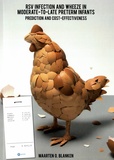RSV infection and wheeze in moderate-to-late preterm infants

Blanken, Maarten
- Promoter:
- Prof.dr. L.J. (Louis) Bont & prof.dr. M.M. (Maroeska) Rovers
- Research group:
- Bont
- Date:
- July 2, 2019
- Time:
- 12:45 h
Summary
The main objective of this project was to develop a cost-effectiveness model for policymakers to specifically target the disease burden of Respiratory Syncytial Virus (RSV) bronchiolitis in late premature children.
Within this project we have shown RSV bronchiolitis has a causal role in the inception of wheezing in the first year of life. Prematurity is the most important risk factor for a serious course of a RSV infection. We have developed a risk score instrument with which we can identify a group of late preterm children of 32-36 weeks of gestation with two to three times the risk of hospitalization with an RSV infection. We call these children the "high risk" group although late premature children in themselves already have an increased risk of hospitalization. This high risk group is also the group in which we can best reduce the burden of disease by protecting them against the virus with RSV immunoprophylaxis (palivizumab).
We have developed a cost-effectiveness model in which targeted RSV immunoprophylaxis for high-risk late preterm children was compared to no protection. We used a societal perspective and a time horizon of 1 year. The results of the cost-effectiveness analysis show that against the current cost of prophylaxis, the use of RSV-immunoprophylaxis palivizumab is not cost-effective (ICER> 200,000 / QALY). This model is directly applicable to future analyzes of improved immunoprophylaxis (extended half-life), cheaper immunoprophylaxis (biosimilar) or an RSV vaccine for infants or for the pregnant mother (maternal).
With these products in development and our research contribution, we are hopeful for a future with a lower RSV disease burden for preterm children.